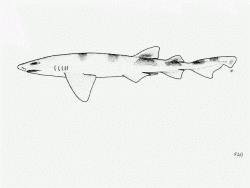select your film:


Balloon Sharks, also known as Indian swellsharks, are endemic to Mozambique and South Africa in the western Indian Ocean at depths between 40 to 600 m over sandy and muddy flats.
Biology and Behaviour
Balloon sharks are thick bodied catsharks with a broad flattened head and a short tail. It has a colour pattern of faint dark saddles on a light grey background along its back and tail. Young balloon sharks have more prominent markings of the saddles than older balloon sharks. They have about 60 upper tooth rows and 44 lower tooth rows. Out of their five gill slits, the third pair is the longest slit.
Like other swellsharks, balloon sharks can inflate its stomach with water or air as a defence mechanism against predators. They feed on a variety of crustaceans, cephalopods and fishes.
Reproduction and Lifespan
Balloon sharks are oviparous and females lay eggs in pairs. Young balloon sharks are 20 to 22 cm long at birth and males and females mature between 70 to 75 cm long. They can reach 110 cm long.
Conservation and Tourism
The IUCN lists balloon sharks as least concern, and the current population trend is stable. There are currently no conservation measures in place for this species.
Do you have images or videos of Balloon Sharks?
Submit them to [email protected].
